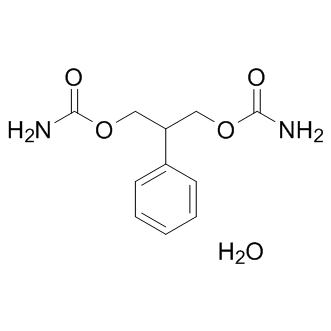Felbamate hydrate (Synonyms: W-554 hydrate; ADD-03055 hydrate) |
| Catalog No.GC15363 |
N-methyl-D-aspartate (NMDA) inhibitor
Products are for research use only. Not for human use. We do not sell to patients.

Cas No.: 1177501-39-1
Sample solution is provided at 25 µL, 10mM.
Felbamate (hydrate) (W-554 (hydrate)) is a potent nonsedative anticonvulsant whose clinical effect may be related to the inhibition of N-methyl-D-aspartate (NMDA) .
Felbamate (W-554) is an anti-epileptic drug used in the treatment of epilepsy. It is used to treat partial seizures (with and without generalization) in adults and partial and generalized seizures associated with Lennox-Gastaut syndrome in children. However, an increased risk of potentially fatal aplastic anemia and/or liver failure limit the drugs usage to severe refractory epilepsy[1]. Felbamate (W-554) has been proposed to a unique dual mechanism of action as a positive modulator of GABAA receptors and as a blocker of NMDA receptors, particularly isoforms containing the NR2B subunit. Although it is clear that felbamate does cause pharmacological inhibition of NMDA receptor of relevance of NMDA receptor blockade as a strategy for the treatment of human epilepsy has been questioned. Therefore, the importance of the effects of felbamate on NMDA receptors to its therapeutic action in epilepsy is uncertain[2].
References:
[1]. Kuo CC, et al. Use-dependent inhibition of the N-methyl-D-aspartate currents by felbamate: a gating modifier with selective binding to the desensitized channels. Mol Pharmacol. 2004 Feb;65(2):370-80.
[2]. Harty TP, et al. Felbamate block of recombinant N-methyl-D-aspartate receptors: selectivity for the NR2B subunit. Epilepsy Res. 2000 Mar;39(1):47-55.
Average Rating: 5 (Based on Reviews and 37 reference(s) in Google Scholar.)
GLPBIO products are for RESEARCH USE ONLY. Please make sure your review or question is research based.
Required fields are marked with *




















